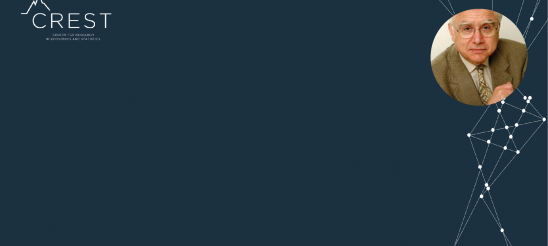Paola Tubaro participe à l’émission Parlons-en de la chaîne France24 sur la thématique “Doit-on travailler avec ou contre l’intelligence artificielle ?” avec Jean Cattan, secrétaire général du Conseil national du numérique, Yann Lechelle, co-fondateur et directeur général de Probabl, spinoff d’Inria spécialisée dans les outils d’IA et de science de données pour les entreprises, et Caroline Fredrickson, Directrice du département de la recherche à l’OIT.
01/05/2025
Hommage à Claude Henry, fondateur du Laboratoire d’économétrie de l’X

Le professeur Claude Henry, éminent physicien devenu économiste, est décédé le 17 avril 2025. Figure majeure de la recherche économique française, il a profondément marqué les domaines de l’économétrie, de la régulation publique et du développement durable.
Un parcours académique d’exception
Formé initialement en physique, Claude Henry a orienté sa carrière vers l’économie, intégrant l’École polytechnique où il a enseigné pendant plus de trente ans. Il y a fondé en 1970 le Laboratoire d’économétrie, qu’il a dirigé et transformé en un centre de recherche de renommée internationale. Ce laboratoire, devenu plus tard le Centre d’Économie de l’École polytechnique (CECO), a accueilli de nombreux chercheurs de renom, dont Jean-Jacques Laffont dans les années 1970.
Claude Henry a également occupé des postes de professeur à Sciences Po Paris et à l’université Columbia à New York. Ses recherches ont couvert un large éventail de sujets, allant des interactions faibles entre particules élémentaires aux équations différentielles avec discontinuités, en passant par les décisions en incertitude et l’économie des services publics.
Un engagement pour les politiques publiques et le climat
Membre du Conseil d’analyse économique de 1997 à 2002 sous le gouvernement de Lionel Jospin, Claude Henry a contribué à des réflexions majeures sur la fiscalité environnementale, la régulation des services publics et la propriété intellectuelle.
Son ouvrage Microeconomics for Public Policy: Helping the Invisible Hand (Oxford University Press, 1987) illustre son approche visant à éclairer les décisions publiques par l’analyse économique. En décembre 2006, une conférence internationale a été organisée en son honneur, reflétant son intérêt constant pour les politiques publiques.
Claude Henry a également été un fervent défenseur de l’action contre le changement climatique. Il a publié de nombreuses tribunes dans Le Monde appelant à des politiques environnementales ambitieuses et a coécrit avec Joseph Stiglitz des travaux sur la propriété intellectuelle et le développement durable.
Distinctions et héritage
Claude Henry était membre de l’Academia Europaea et Fellow de l’Econometric Society. Il a reçu la médaille d’argent du CNRS en 1991.
Son héritage perdure à travers ses nombreuses publications et l’influence qu’il a exercée sur des générations de chercheurs et de décideurs. Ses contributions continueront d’inspirer les efforts en faveur d’une économie au service du bien commun et de la transition écologique.
Pauline Rossi, pour le Figaro : “La découverte du déclin démographique ressemble à celle du changement climatique”
La part du genre dans les sciences sociales
Dans une étude à paraître dans la revue Actes de la recherche en sciences sociales et chroniquée ce jour dans le journal Le Monde : “Il n’y a pas d’obsession pour le genre dans les sciences sociales en France : une vaste étude le démontre“, Samuel Coavoux, Etienne Ollion et plusieurs collègues ont étudié la place donnée au genre dans les sciences sociales.
La question a un intérêt scientifique évident. Elle permet aussi de revisiter certains débats publics récents — par exemple sur la place du “wokisme” à l’université.
L’enquête est inédite dans son ampleur : les auteurs ont analysé l’ensemble des publications de sciences sociales françaises depuis 25 ans.
L’enquête est innovante aussi, elle utilise des outils récents d’intelligence artificielle, développés au sein de l’équipe de sciences sociales computationnelles du CREST.
Les résultats sont parlants, et parfois inattendus :
- Le recours au genre comme grille d’analyse a augmenté au cours des 25 dernières années,
- Certaines disciplines ont été pionnières (démographie, anthropologie, histoire, sociologie), d’autres s’y sont intéressées plus récemment (histoire, sciences de gestion)
- Mais la mobilisation du genre est in fine limitée. Avec 12% du total des articles qui évoquent le genre, on est loin de l’invasion dénoncée par certains.
- L’approche de genre est encore très majoritairement le fait de femme. Entre 2016 et 2022, 66 % des articles mobilisant cette perspective ont été écrits par des femmes ou une majorité de femmes, une proportion stable dans le temps. L’augmentation du genre dans les publications pourrait bien être la conséquence de la féminisation des disciplines.
L’étude, la première au monde à analyser le genre dans les publications avec des outils d’intelligence artificielle, est disponible ici
La presse en parle :
Pierre Rousseaux contribue à l’évaluation de la réforme de l’assurance chômage
Pierre Rousseaux, doctorant au CREST-GENES et affilié à l’Institut des Politiques Publiques (IPP), est co-auteur du rapport d’évaluation de la réforme du Salaire Journalier de Référence (SJR), pilier central de la réforme de l’assurance chômage mise en œuvre entre 2019 et 2021.
Intitulé “Réforme du salaire journalier de référence et trajectoires professionnelles“, ce rapport a été publié en avril 2025 dans le cadre des travaux du comité d’évaluation piloté par la Direction de l’Animation de la recherche, des Etudes et des Statistiques (Dares). Il analyse de manière rigoureuse les effets de cette réforme sur les droits à l’indemnisation, les comportements de recherche d’emploi, et les trajectoires professionnelles des demandeurs d’emploi.
Les auteurs mettent notamment en évidence que la réforme a entraîné une baisse de l’allocation journalière pour les personnes aux parcours discontinus, contrebalancée par un allongement de la durée d’indemnisation. A court terme, elle a aussi induit une hausse du nombre de jours travaillés, sans effets notables sur la qualité des emplois retrouvés.
Dans un contexte de réflexion sur une nouvelle réforme de l’assurance chômage, cette évaluation apporte un éclairage précieux sur les mécanismes en jeu et les arbitrages possibles entres incitations et protection.
👉 Lire le rapport complet
📄 Lire la synthèse
🔎 Page dédiée sur le site de l’IPP
Ce travail a été mené dans le cadre des travaux du Comité d’évaluation de la réforme de l’Assurance chômage initiée en 2019, et a bénéficié d’un financement de la Direction de l’animation de la recherche, des études et des statistiques (Dares) dans le cadre de l’appel à projets de recherche « Suivi quantitatif des effets de la réforme de l’assurance chômage pour les demandeurs d’emploi ».
Patricia Crifo, sur l’intégration des dimensions économiques et financières dans la transition écologique dans l’enseignement des futurs ingénieurs
Patricia Crifo, “Ingénieurs et transition écologique : adapter les formations aux enjeux de demain”
ID L’info Durable
31/03/2025
Prix Nobel d’économie : l’équilibre délicat entre la technologie, les institutions et le pouvoir
Thomas Peyrat publishes two new advances in applied probability
Thomas Peyrat, PhD student at CREST-GENES and at Exiom Partners, in Finance-Insurance, has just reached a major milestone in his doctoral journey with the publication of his first paper in ESAIM: Probability and Statistics, as well as the release of a new working paper.
These two works, conducted in collaboration with his advisors Caroline Hillairet (ENSAE Paris – CREST) and Anthony Réveillac (INSA Toulouse – Toulouse Mathematics Institute), are part of his PhD carried out in partnership with Exiom Partners, a consulting firm actively involved in applied research.
🔹 A new Clark–Ocone formula for Poisson functionals
The first paper, titled A non-compensated Clark–Ocone formula for Poisson functionals, develops a decomposition formula for integrable Poisson functionals. This non-compensated version offers several technical advantages compared to the classical compensated approach, paving the way for new potential applications.
👉 Read the article in ESAIM: Probability and Statistics
🔹 Multivariate self-exciting processes with dependencies
The second work, currently available as a preprint, introduces a new class of multivariate self-exciting processes capable of modeling dependencies between event intensities and values. This modeling framework is particularly promising in insurance applications, for instance to capture links between claim frequency and severity.
👉 Read the preprint
We warmly congratulate Thomas for these important contributions, which highlight the strength of collaboration between academic research and industry, as well as the quality of doctoral training at CREST.
Contribution de Pierre Rousseaux à l’Investment Report 2024/2025 de la European Investment Bank (EIB)
Pierre Rousseaux, doctorant au CREST-GENES, signe une contribution dans l’Investment Report 2024/2025 de la Banque Européenne d’Investissement (BEI) (Encadré C, Chapitre 5).
Dans un contexte de tensions géopolitiques croissantes, les dépendances commerciales de l’Union européenne deviennent un enjeu stratégique majeur. La guerre en Ukraine, la montée du protectionnisme aux États-Unis et la concentration des chaînes de valeur en Chine exposent l’UE à des risques accrus de perturbations d’approvisionnement. Quels sont les produits et secteurs les plus vulnérables ? Quelles sont les dépendances critiques ? Comment renforcer la résilience européenne ?
Dans cette contribution, Pierre Rousseaux explore ces questions sur une période plus étendue que celle abordée dans son précédent travail coécrit avec Isabelle Méjean pour le CEPR – Centre for Economic Policy Research. Voici les principales conclusions issues de son analyse pour la BEI :
-
Les vulnérabilités sont de plus en plus concentrées sur les importations chinoises
La part de la Chine dans les dépendances commerciales de l’UE a significativement augmenté, tandis que celle des États-Unis et du reste du monde a diminué de 3 à 10 points de pourcentage. -
Les dépendances en amont des chaînes de valeur sont les plus risquées
Les vulnérabilités situées à plus de trois étapes du consommateur final représentent 49 % des produits critiques. Une rupture dans ces segments pourrait affecter l’ensemble des chaînes d’approvisionnement européennes. -
Certaines dépendances sont structurellement critiques pour l’industrie européenne
Les produits vulnérables se concentrent dans les secteurs de la chimie, des métaux et de la céramique — industries essentielles pour de nombreuses filières stratégiques. -
Ces vulnérabilités sont persistantes
41 % des dépendances commerciales identifiées avant la crise financière mondiale étaient encore présentes après celle-ci, et 35 % ont perduré à long terme, témoignant de leur caractère structurel et de la difficulté à s’en détacher. -
Sur les 5 381 produits importés par l’UE, le nombre de vulnérabilités identifiées varie selon les critères retenus : entre 359 (avec les critères les plus larges) et 29 (selon les cinq critères les plus restrictifs définis avec Isabelle Méjean). Bien que ce chiffre puisse sembler faible, il regroupe des produits à risque extrême, caractérisés par :
-
une forte concentration des fournisseurs hors UE
-
une très faible production au sein de l’UE
-
une capacité de substitution quasi inexistante en cas de choc
-
Pourquoi est-ce crucial ?
Identifier précisément les dépendances et leurs risques permet de concevoir des politiques ciblées : diversification des fournisseurs, relocalisation, investissements stratégiques… Ces enjeux dépassent la sphère économique : ils ont un impact direct sur la souveraineté industrielle et technologique de l’UE.
Pierre Rousseaux propose également une page dédiée à ce sujet sur son site, qui croise les résultats de son papier avec Isabelle Méjean et ceux réalisés pour la BEI. Elle s’adresse aux publics académique, statistique et politique, et permet d’explorer les vulnérabilités commerciales de l’UE de manière approfondie :
https://www.pierrerousseaux.com/eu-trade-dependencies
Consulter le rapport complet ici.
Électricité, eau, CO2 : pourquoi le Bitcoin est responsable de 95% de l’impact environnemental des cryptomonnaies
Julien Prat pour le média Vert
19/03/2025










